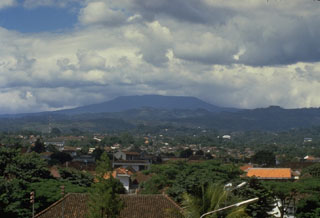Report on Tangkuban Parahu (Indonesia) — 4 June-10 June 2025
Smithsonian Institution / US Geological Survey
Weekly Volcanic Activity Report, 4 June-10 June 2025
Managing Editor: Sally Sennert.
Please cite this report as:
Global Volcanism Program, 2025. Report on Tangkuban Parahu (Indonesia) (Sennert, S, ed.). Weekly Volcanic Activity Report, 4 June-10 June 2025. Smithsonian Institution and US Geological Survey.
Tangkuban Parahu
Indonesia
6.77°S, 107.6°E; summit elev. 2084 m
All times are local (unless otherwise noted)
The Pusat Vulkanologi dan Mitigasi Bencana Geologi (PVMBG) reported increased unrest at Tangkuban Parahu during late May-early June. Steam-and-gas plumes rose as high as 110 m above the vents in Ratu Crater. The seismic network recorded an increase in signals indicating gas venting to 21-37 events per day during 30 May-1 June and a total of 100 low-frequency events that suggested the movement of fluids to shallow depths. During 1-8 June steam-and-gas plumes rose as high as 150 m above the vents at Ratu Crater and 5-10 m above the vents at Ecoma Crater. Continuous tremor began at around 2200 on 5 June and was coincident with bubbling or boiling mud Ratu, where black mud deposits surrounded the pool. Thermal areas at both Ratu and Ecoma craters imaged by drone showed no enlargement of the thermal areas between 5 and 7 June. The seismic network recorded 16 and 3 low-frequency events on 7 and 8 June, respectively; seismicity remained elevated through 8 June. Deformation data indicted continuing inflation. As of 8 June the proportions of gas species had not shown notable changes, and gas concentrations were within normal limits. The Alert Level remained at 1 (on a scale of 1-4) and tourists were advised not to descend into the craters.
Geological Summary. Gunung Tangkuban Parahu is a broad stratovolcano overlooking Indonesia's former capital city of Bandung. The volcano was constructed within the 6 x 8 km Pleistocene Sunda caldera, which formed about 190,000 years ago. The volcano's low profile is the subject of legends referring to the mountain of the "upturned boat." The Sunda caldera rim forms a prominent ridge on the western side; elsewhere the rim is largely buried by deposits of the current volcano. The dominantly small phreatic eruptions recorded since the 19th century have originated from several nested craters within an elliptical 1 x 1.5 km summit depression.
Source: Pusat Vulkanologi dan Mitigasi Bencana Geologi (PVMBG, also known as CVGHM)

